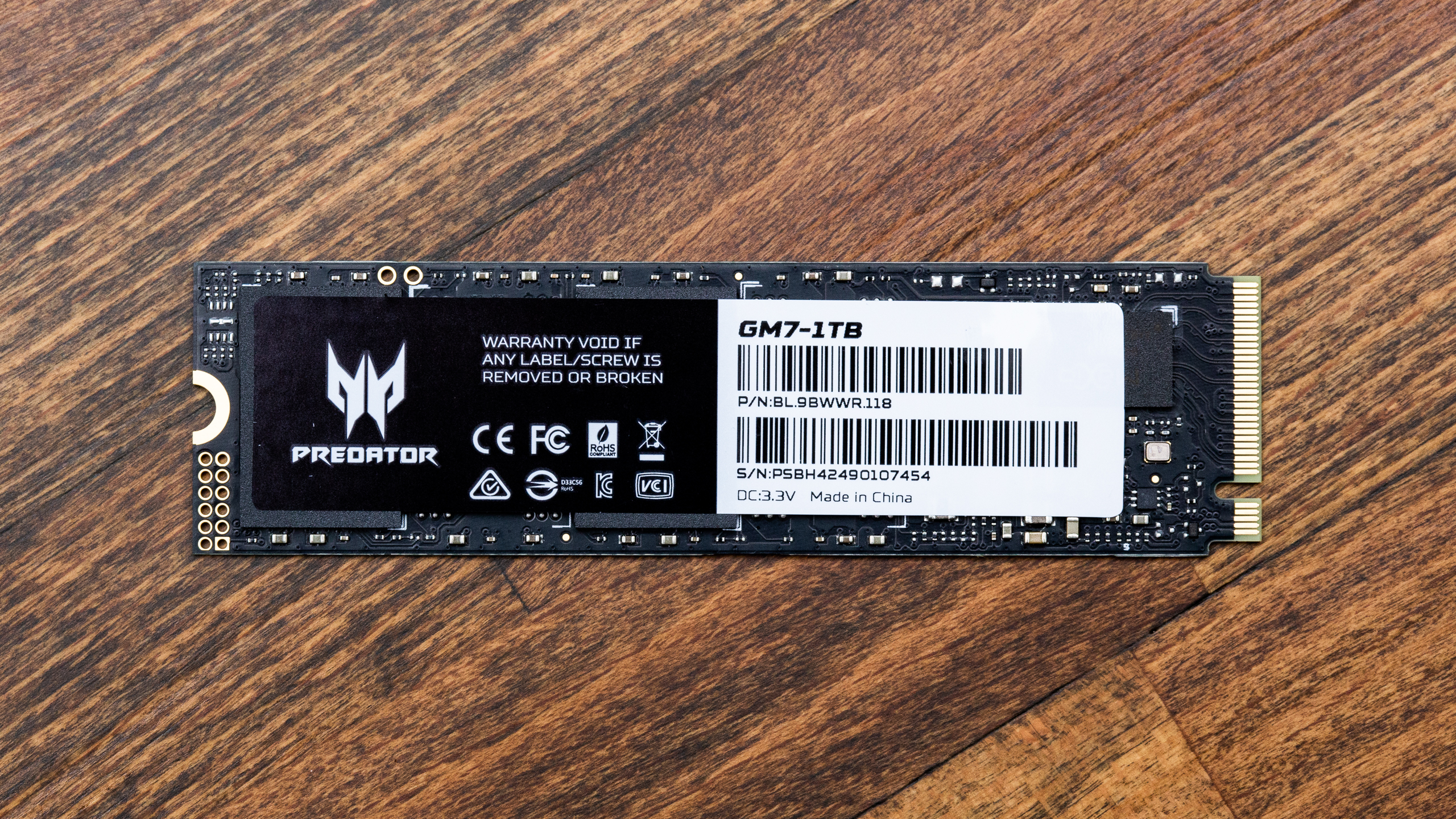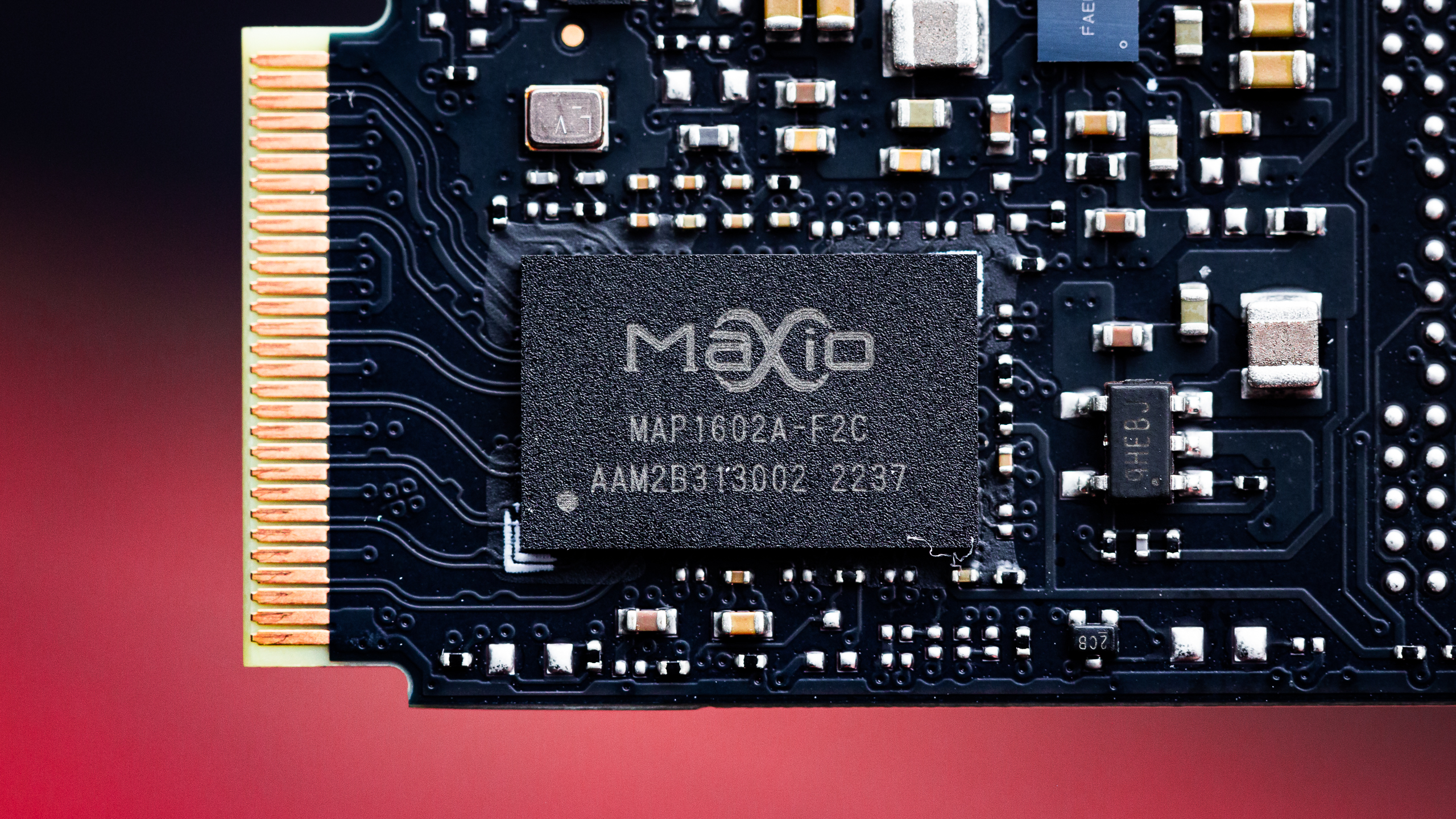Tom's Hardware Verdict
The 1TB Acer Predator GM7 is a fast and extremely efficient PCIe 4.0 SSD. It’s not the fastest drive on the market, but it brings high-end performance at a lower price point. Its design also makes it an excellent choice for laptops.
Pros
- +
The most efficient and cool SSD we’ve tested to date
- +
Good all-around performance
- +
Good performance in sustained workloads
- +
Reasonable warranty
Cons
- -
Not yet using the newest flash
- -
Pricing and availability questions
- -
No software support
Why you can trust Tom's Hardware
The Acer Predator GM7 is a fast and very efficient PCIe 4.0 SSD. In fact, it’s the most efficient SSD we have tested to date by a significant amount. The GM7's all-around performance is good to great, and its performance in sustained workloads is also quite good. The drive is also single-sided and runs cool, making it one of the best SSDs for laptops and one of the best SSDs for the PS5. The GM7 is also noteworthy for using NAND flash from the China-based YMTC fab, but it doesn't use the company's newest 232-Layer TLC flash, meaning the best might be yet to come.
Acer’s drives are built by Biwin, a company that also supplies HP. The Predator GM7 uses a new Maxiotek controller that can push the limits of the PCIe 4.0 interface with just four channels. More interestingly, this drive also uses 3D TLC flash from YMTC, a China-based foundry. Recent political events have taken YMTC from being disruptive, with the first 232-Layer flash on the market, to a pariah, as it lost a contract with Apple and may be unable to import its flash to the U.S. This has been quite challenging for the NAND manufacturer. Our current Predator GM7 sample uses a revised version of YMTC’s 128-Layer flash, but the more performant 232-Layer variant is promised and would make for an even better drive. Competing drives will likely arrive with Micron’s 232-Layer TLC and the TenaFe TC2201 controller, but the GM7 is the efficiency king for now.
Specifications
| Product | 512GB | 1TB | 2TB |
|---|---|---|---|
| Pricing | $49.99 | $89.99 | $159.99 |
| Form Factor | M.2 2280 | M.2 2280 | M.2 2280 |
| Interface / Protocol | PCIe 4.0 x4 / NVMe 2.0 | PCIe 4.0 x4 / NVMe 2.0 | PCIe 4.0 x4 / NVMe 2.0 |
| Controller | Maxio MAP1602A | Maxio MAP1602A | Maxio MAP1602A |
| DRAM | N/A (HMB) | N/A (HMB) | N/A (HMB) |
| Memory | YMTC TLC | YMTC TLC | YMTC TLC |
| Sequential Read | N/A | 7,400MBps | 7,400MBps |
| Sequential Write | N/A | 6,300MBps | 6,700MBps |
| Random Read | N/A | N/A | N/A |
| Random Write | N/A | N/A | N/A |
| Security | N/A | N/A | N/A |
| Endurance (TBW) | ? | ? | 1300 TBW |
| Part Number | BL.9BWWR.117 | BL.9BWWR.118 | BL.9BWWR.119 |
| Warranty | 5-Year | 5-Year | 5-Year |
According to the datasheet we received, the Acer Predator GM7 will be available in 512GB, 1TB, and 2TB flavors. The product’s box also lists a 4TB SKU, which would be a tall order for this drive’s budget controller. It’s technically capable of 4TB but would need 1Tb dies. Performance peaks at the 2TB model.
The 1TB Predator GM7 is rated for up to 7,400/6,300 MBps of sequential read/write performance, but the datasheet implies a future 2TB model could hit 7,400/6,700 MBps. The performance in random workloads is currently not defined, but the similar Zhitai TiPlus7100 SSD can reach up to 900K/700K in random read/write workloads, and the controller is capable of up to 1M/1M.
The Predator GM7 has a five-year warranty, and the 2TB model has a 1,300 TBW (total bytes written) endurance rating. Thus, the drives would likely have a 650TB-per-TB-of-capacity rating, but be sure to look for an official spec for the other capacity points.
The datasheet lists NVMe 2.0 support, and the controller also supports this spec revision, but the box and CrystalDiskInfo indicate NVMe 1.4 for this drive. Our model is listed as BL.9BWWR.118 on the box, and given the product naming conventions of the Acer Predator GM7000, we made some guesses for 512GB and 2TB models.
At the time of review, the Predator GM7 was not widely available, but pricing is expected to be $49.99, $89.99, and $159.99 for the three launch capacities. This is not competitive with mid-range PCIe 4.0 SSDs like the Silicon Power UD90, which have been $74.99 or less for 1TB, but the pricing gives it a good starting point for sales against high-end PCIe 4.0 drives like the WD Black SN850X.
Software and Accessories
The Acer Predator GM7 does not list free Acronis cloning software on its datasheet as the Predator GM7000 does. We recommend Macrium Reflect Free for your imaging and cloning needs. For information about the drive, use CrystalDiskMark or similar software to check drive health and other data.
Get Tom's Hardware's best news and in-depth reviews, straight to your inbox.
A Closer Look



The 1TB Acer Predator GM7 is a plain, single-sided SSD. There is a small controller with no DRAM package and two NAND packages. It is possible to populate this PCB with up to four NAND packages. It would be possible to get up to 4TB with 1Tb dies, but this drive would be best at 2TB with that flash, and possibly best at 1TB with the 512Gb dies our sample uses. The single-sided design makes it a good fit for some slim devices, like laptops.
The controller is the Maxio MAP1602A, also known as the MAP1602 or MAP1602-I. Maxio, or Maxiotek, is a spin-off from JMicron, which once made SSD controllers. This particular controller is made in the 12nm TSMC process node with an ARM Cortex-R5 architecture, distinct from the 22nm TSMC node used on the MAP1202. It is four-channel and DRAM-less, suggesting it should be very efficient. Unlike other DRAM-less PCIe 4.0 controllers we’ve tested, this one has a 2400 MT/s bus that allows it to saturate the interface. This will also make it more power efficient.
The flash is Biwin-binned and packaged YMTC TLC. Like the TiPlus7100, this drive was expected to have YMTC’s newest 232-Layer TLC but actually arrived with a stopgap variation of its 128-Layer design. The 232-Layer TLC will have six planes like Micron’s 232-Layer TLC, as seen in our Phison E26 Preview, along with independent plane operation similar to Micron’s. This flash also has a center X-decoder, like SK hynix’s 176-Layer TLC in the Platinum P41, improving sub-page I/O performance. Other changes will help bring the complexity and cost of the flash down — an area that has been an issue — and allow high die density.
The four-plane 128-Layer variation found on our review sample does not have the new Xtacking 3.0 technology and has a different 2x2 plane layout than the original 128-Layer design. YMTC’s Xtacking uses wafer-on-wafer technology to bond separate CMOS circuitry — page buffers, charge pumps, etc. — on a flipped flash array. Architectures from other flash manufacturers instead have the CMOS under the memory array. YMTC’s design reduces development time and the time to market, plus it has benefits for die density and efficiency, but it is more costly. Challenges include bonding wafers with distinct characteristics, such as different coefficients of thermal expansion (CTE), which require novel vias/plugs to handle the stress.
MORE: Best SSDs
MORE: Best External SSDs and Hard Drives
MORE: How We Test HDDs And SSDs
MORE: All SSD Content

Shane Downing is a Freelance Reviewer for Tom’s Hardware US, covering consumer storage hardware.
-
cfbcfb Biwin has sold some of their drives made for HP/Acer as a seller on Amazon. I bought one of the GM7000 drives last year as a Biwin drive for a pretty good price. Great performer, no problems. Looks like they make memory, drives and other pcie cards like network adapters for HP and Acer.Reply
I also got a Chuwi mini pc (ugh, don't get me started) that came with biwin ram and ssd, so they're replacing kingston and those other low end brands as branded components. -
jpetso You write about this being an excellent choice for laptops in the summary card, and about idle power consumption for ultrabooks in the Power Efficiency, but there isn't any data in this review to prove it. Idle power is only measured with power management disabled, and the only wattage measurements are for 50GB file copies. Neither of those is relevant for regular laptop usage.Reply
Please bring on idle testing with full laptop-grade power management enabled, and wattage consumed with light web surfing loads.

